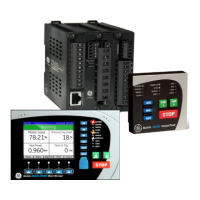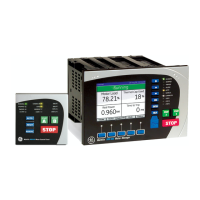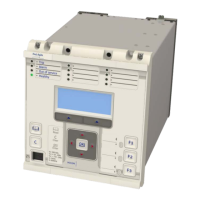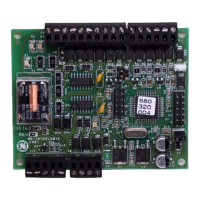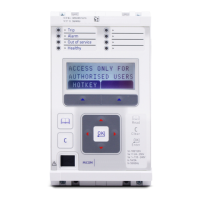6.3 IMPLEMENTATION OF DISTANCE PROTECTION FOR ISOLATED AND COMPENSATED
NETWORKS
When applying distance protection to compensated or isolated systems, the following key points must be taken
into account:
● Distance protection must not trip for a single-phase to earth fault
● In the case of cross-country faults, the protection methods are different from that of solidly earthed
systems. In this case either a cyclic or an acyclic logic should be used to select a phase preference for the
impedance measurement
6.3.1 NETWORK EARTHING SYSTEM SETTING
The setting Dist.Earth Mode in the DISTANCE SETUP column defines the behaviour of the distance protection
function according to the type of earthing system. The setting options are:
● Is/Comp Earthing for isolated or compensated systems
● Standard for directly earthed systems
If Is/Comp Earthing is selected:
● Distance protection is blocked for a single-phase to earth fault
● A earth fault is detected using the neutral current (IN) and/or the neutral voltage (VN)
● It has no influence on two-phase or three-phase fault performance
● In the case of cross-country faults, either a cyclic or an acyclic logic is invoked to select a phase preference
for the impedance measurement
● The DDB signal Is/Comp Enabled (1983) is asserted
6.3.2
FIRST EARTH FAULTDETECTION
In isolated or compensated mode, no trip should occur for a earth fault. Moreover its detection by means of an
impedance criteria would lead to false information as voltages around the galvanic network will be 0V for the
faulty phase. Instead, an earth fault is detected by comparing I
N
and/or V
N
with a settable threshold.
You can choose to use V
N
only, I
N
only, V
N
OR I
N
, or V
N
AND I
N
as your selection criteria. The mode is set by the
setting 1P Mode in the DISTANCE SETUP column. The single-phase to earth fault signal (IS/Comp EF) is then
produced after a time delay set by 1P Time delay.
I
N
> can be set from 0.05In to 1In in steps of 10 mA. V
N
can be set from 1V to 80V in steps of 1 V.
A pick-up timer, is available for the detection of the first earth fault. This can be set from 0 to 10 seconds in steps of
10 ms.
The mode selector decides whether the single-phase to earth fault is determined by VN> only, IN> only, VN> or IN>,
or VN> and IN>. The mode is set by the setting 1P Mode in the DISTANCE SETUP column. The single-phase to earth
fault signal (IS/Comp EF) is then produced after a time delay set by 1P Time delay.
6.3.2.1 NEUTRAL VOLTAGE CRITERIA
The influence of earth current in a fault can be determined by considering the changes in phase to phase and
neutral displacement voltages. During earth faults, a significant displacement of the neutral voltage is expected,
whilst no imbalance of the voltage triangle is to be expected. The following figure shows a Phase A to earth fault.
Chapter 7 - Distance Protection P543i/P545i
184 P54x1i-TM-EN-1
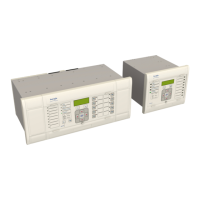
